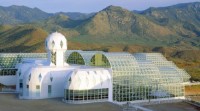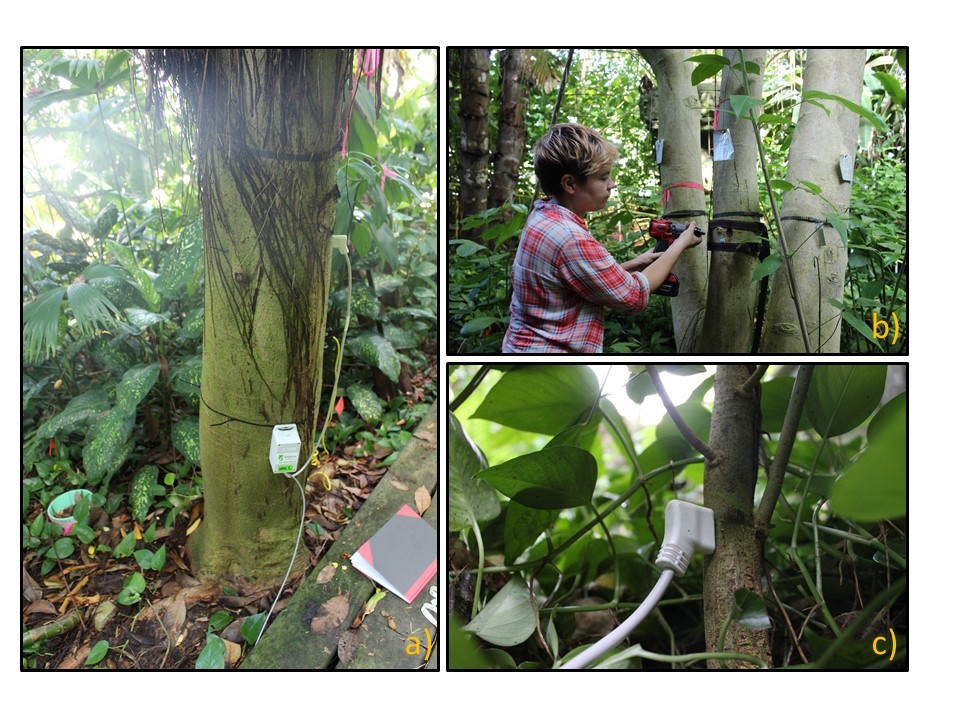Biosphere 2 and sap flow sensors: how do tropical trees behave under drought?

monitoring water uptake and transport of a model rainforest ecosystem
Author: Kathrin Kühnhammer
PhD Student at TU Braunschweig, Environmental Geochemistry, Germany

Pictures of a) tropical rainforest glass house in the Biosphere 2 complex, b) inside the tropical rainforest model ecosystem and c) water content and sap flow sensor as well as borehole to measure water stable isotopes in tree xylem in situ.
Together with a large group of scientists from all over the world, the junior research group “Isodrones” (www.isodrones.de) took part in the highly interdisciplinary research project B2 WALD (Water, Atmosphere and Life Dynamics) at Biosphere 2, Arizona, USA.
The project was based in a tropical model ecosystem and aimed at enhancing our knowledge about dynamic changes of carbon and water cycling in view of a changing climate.
Over the four-months experiment the rainforest was first exposed to a drought for two months.
Subsequently, the system was rewetted from the bottom and then from the top, with multiple, independent irrigation events.
We followed the water moving across the rainforest and quantified transpired water amounts and its sources by combining the Implexx Sap Flow Sensor with novel in situ methods to measure water stable isotopes in soils, plant xylem, plant transpiration and the atmosphere.
the B2 WALD project at Biosphere 2
We are in the Catalina mountains, in the Sonoran Desert, more than an hour drive from the nearest city, Tucson. The air is hot and dry. But after walking a few hundred meters, inside a building that looks like a stranded spaceship, after passing some airlocks and a whole underground system of pipes and cables, I reach a completely different environment. This is where I spent the majority of my time during the three months at Biosphere 2 – in a tropical rainforest inside a massive glass pyramid. This artificial 30-year old ecosystem houses around 90 different plant species on an area of 2000 m² containing soils with up to three meters depth.
We used this unique setting to study what happens to tropical plants, both on an individual as well as an ecosystem level, under drought. How do trees react? What water use/saving strategies do they have? How resilient are they? How important are deep roots for rainforest species under drought? And how does a whole ecosystem react, from soils and roots through plants and to the atmosphere?
Unlike in an outdoor field campaign, a lot in this indoor ecosystem is controllable. We can control air temperature, relative humidity and amount of rain. Also, as this is a closed, small-scale ecosystem, effects of changing environmental conditions translate a lot quicker and more pronounced into plant and ecosystem responses. This provides a unique opportunity to conduct experiments, somewhere between laboratory model study and field study. The “Isodrones” project investigates the importance of deep roots for whole tree water uptake. Therefore, the most exciting feature for us was the fact that we could add water to the bottom of the root zone using existing drainage pipes and thus label the whole deep soil with water containing higher amounts of deuterium, the heavier stable isotope of hydrogen. We followed how trees responded to this, investigated how important the supply with deep soil and groundwater is during drought and also how the contribution of deep-water changes, when restarting irrigation from the soil surface.

a) Sap flow and water content sensor installed in a big tree (here: Pachira aquatica), b) Kathrin installs a sap flow sensor in an individual of Clitoria fairchildiana and c) installed sap flow sensor in a small stem of the species Hibiscus rosa sinensis.
sap flow scientific research
We installed a total of 16 sap flow sensors, recording changes in water transport of 7 different species, from small bushes (Hibiscus rosa sinensis) to big trees (Hura crepitans).
Transpiration and water transported and taken up by plants is closely linked to stomatal opening. Therefore, water deficit also influences photosynthesis and carbon cycling.
Additionally, sap flow transports nutrients taken up by roots to all aboveground plant parts.
Consequently, measured sap flow rates will not only be used to interpret changes in the water cycle but provide an important parameter for all participating research groups to assess plant water status and the interconnection of carbon and water cycling.
Depending on tree species and the individuals’ size, we saw different reactions towards drought and rewetting and gained new insight into tree water uptake, storage and transport dynamics. The data collected is being processed right now and will be published in the near future.
The experiment emerged from the ERC grant VOCO2 and was also supported by the University of Arizona - Biosphere 2, the Philecology Foundation, and Susan and Daniel Warmack. “Isodrones” are founded by the Volkswagenstiftung.
further information
For more information on this experiment, contact Kathrin Kühnhammer (k.kuehnhammer@tu-braunschweig.de) or Dr. Matthias Beyer (matthias.beyer@tu-bs.de). It is possible to conduct research with us in the framework of a MSc thesis or other research visits. Also check out our homepage for frequent updates: www.isodrones.de.
Former Sap Flow Digest blog article on “Isodrones” first field campaign in Costa Rica: https://edaphic.com.au/sap-flow-digest/drones-and-sap-flow-sensors/
More information on sap flow sensors: www.edaphic.com.au/products/sap-flow-sensors/
information and news coverage on the B2 WALD project
B2 WALD project description on the Biosphere 2 website:
VOCO2 project description: https://www.cep.uni-freiburg.de/forschungsprojekte/VOCO2
Article of UA News on the first rain after the drought:
https://uanews.arizona.edu/story/rainforest-under-glass-kissed-rain-after-twomonth-drought
Science Friday Radio interview on the experiment:
https://www.sciencefriday.com/segments/state-of-science-biosphere-drought/
Radio report from KNAU reports:
https://www.wbur.org/hereandnow/2019/12/20/drought-rainforest-science
Interview with Rainforest Science Director Dr. Laura Meredith on the B2 WALD experiment:
